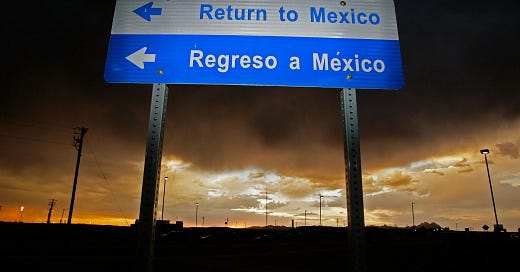The Great Repatriation and Native Born Hispanics
Voluntary repatriation is just as necessary and workable
Our core premise is that Western peoples deserves their own voice, its own political institutions and a future free from interference or predation by outside groups. Westerners are a global minority and are now becoming minorities in their own homelands. The inevitable and necessary result of this is a growing political movement of explicitly nationalist news outlets, publishers, and political pressure groups.
Unfortunately, however, it is not uncommon to hear the language of hopelessness or despair about the demographic situation in many Western nations. Nationalists, more than anyone, know the data. They look at the graphs, charts and trends, and understand what will be lost if current trends continue. But, this awareness often leads to nationalists feeling that nothing can ever be done, even if nationalist policymakers were to be installed in the highest ranks of the State apparatus.
We know something CAN be done. Something MUST be done.
Repatriation, the return of recent immigrants and their descendants to their respective homelands or perhaps third-party non-Western states, is central to the survival of our nations. Most importantly, though, it is a practical policy which we must enact.
In the first of the original four pieces on the Great Repatriation we started with the general Hispanic population of the United States. In that first piece we outlined how a series of policy changes could bring about the removal of up to 47% of the Hispanic population of the United States. We highlighted the fact that 33% of all Hispanics, and 45% of Hispanic adults, in the United States are foreign born and therefore already hold, or are eligible for, the citizenship of another country.
The post also covered a crucial Yale study, which found that in 2018 there were likely more than 22 million illegal aliens in the United States. The more liberal projections in the study predicted as many as 30 million illegals were present in the US. That study, now some 8 years out of date, is likely off by 10 million or more people, as the US border is subject to daily mass-crossings which are facilitated by the American state.
Finally, in the Great Repatriation and The Willing, the fourth and final part of the original series, we briefly mentioned the attitudes of 2nd and 3rd generation Hispanics - as they represent the 67% of US’ Hispanics born in the country.
In this new piece we are going to expand on that demographic of Hispanics by focusing on those who are already adult citizens of the United States, and how they could be enticed to voluntarily depart the country.
A 2020 Pew Study shows that a mere 14% of Hispanics in the United States use the term American to describe themselves. Even among third generation Hispanics in the United States only 33% of individuals label themselves as American. Most Hispanics in the United States (47%) identify with the country their family originates from while the remainder label themselves as either Latino or Hispanic. The fact that these identities hold strongly across generations of US born Hispanics indicates that the ethnic and racial connections to their homelands remain a key factor in their identity and lives. Something which is backed up by other research.
Another fascinating study published in 2011 revealed that Hispanics frequently make return visits to their homelands. Even among 2nd generation Hispanics in the United states the rate of return to their country of ancestral origin was near 40%. while among 3rd generation American-born Hispanics the return figures are quite high with more than a third making some form of return visit.
Building further on later-generation Hispanic lack of identification with the United States is a Pew Research survey from 2016 which clearly outlines how 2nd and 3rd generation Hispanics in the United States increasingly lack the belief that they are doing better than their parents and most strikingly lack the belief that their children will do better than they have. These numbers represent a population of some 7.33 million American-born Hispanics who expect future generations to do worse than they currently are. If we also include those American-born Hispanics who are only doing “about the same” as their parents in these figures the population represented increased to 12.5 million people, or 30% of all American-born Hispanics.
Sofar we have established that:
1. Amerian-born Hispanics do not identify as American at significant rates.
2. American-born Hispanics make frequent return visits to their ethnic homelands.
3. American-born Hispanics are growing increasingly unsure of their ability to do better than their parents, and they are extending this feeling to their future children.
These anxieties are likely a manifestation of a sort of impostor syndrome. Hispanics in the United States are very aware that they represent a foreign element within a nation which is not their own. A fascinating figure which backs up this assertion is a study published in 2019 which shows that even among American-citizen Hispanics some 48% feared they may be subject to deportation. Among all Hispanics in the United States 53% fear deportation, including 73% of non-citizen Hispanics.
The cost:
With these statistics in mind there is one more aspect with mentioning before going into proposed solutions: the fiscal impact of Hispanics in the United States.
The Center for Immigration Studies published work in early 2024 that found the net fiscal drain of a Hispanic immigrant will be 68,000 dollars over the course of their lifetime. This is a cost to America’s overwhelmingly American taxpayer base, but a small one compared to native born Hispanics.
Native born Hispanics, who will be eligible for Social Security, Medicare and a raft of other benefits limited to citizens in most states (for now) have a net negative fiscal impact of some 9,570 dollars each year, or 746,460 dollars over the course of their lifetime. We were able to come to these totals by adjusting the research of The Alternative Hypothesis to 2023 dollars. These figures include Hispanic utilization of other services beyond the welfare state, such as the cost of their crime in police and court services, while the figures about illegal immigrants focus only on welfare expenditures.
The solutions:
With the case having been made that native-born Hispanics are increasingly unhappy in the United States, and unable to adjust to the fiscal demands of residing in a Western society, the best option is for these individuals to be offered incentives for voluntary repatriation.
Many Hispanic individuals, including over 7 million American-born Hispanics, live with illegal or non-citizen family members and could be expected to relocate with relatively few incentives. This will not cover the broader native-born Hispanic population, though.
The first step is to ensure that these American-born Hispanicss are able to renounce their US citizenship and legally relocate to their ethnic homelands, and in most cases they indeed able to relocate with ease. Mexico recently amended their constitution allowing the unincumbered passage of citizenship from one generation to another - thereby giving virtually all 37.2 million Mexican descended persons in the United States the right to a Mexican passport.
The second step is to facilitate relocation. A fascinating datapoint is that 14.5% of Hispanic women are on SNAP (food stamp) benefits at any given moment, with the average SNAP benefit being some $343.00 per household. This figure is just shy of the 400 dollar average rent for an apartment in Mexico city.
If the a nationalist US government were to offer each native-born Hispanic in the United States 10% of their projected lifetime cost to the taxpayer, a payment of 74,656 dollars, it would cover 15 years worth of rent in Mexico or alternatively represent 4.6 years of average income in Mexico. This process need not take place all at once, either. If the United States government were to select part of the budget already taken up by Hispanics, such as the 221 billion dollars Hispanics cost the Medicaid system in 2021, and repurposed half for relocations - the state could relocate some 1.5 million Hispanics out of the country each year, or about 15 million people in a decade.
This budget could also be increased incrementally each year as the removal of this population will free up resources from other programs such as SNAP, TANF, and the tax-credit system.
A further boon to the relocation case which is less dependent on the willingness of the US government (a nationalist institution in the case of implementing these policies) to cut checks is the recent development of remote work in the post-pandemic era.
Today some 14% of Hispanics in the United States work remotely and could therefore retain their much higher American salaries while relocating to their ethnic homelands. This number could likely be driven higher through work from home promotion by a nationalist government seeking to relocate as many recent immigrants as quickly and humanely as possible.
Demographic Change:
Assuming the aforementioned 12.5 million 2nd and 3rd generation American-born Hispanics form a core of individuals most willing to depart the United States, and combining this figure with the 31 million removable individuals in the original Great Repatriation and Hispanics piece, the United States could see 43.5 million Hispanics depart the country, or 70% of the Hispanic population.
These combined suites of policies would reduce the resident Hispanic population of the United States to roughly 20 million people, which corresponds to estimates by the Pew Research Center which found that had it not been for post-1965 mass immigration the Hispanic population of the United States would be some 20 million people, comprising just 8% of the American population. This stands in stark contrast to the 62.1 million Hispanics which currently represent 19% of the American population.

Whatever path and policies are decided upon, it is clear that Americans have a vested interest in ending the demographic transformation of their country and the bankruptcy that it is leading too. It is also clear that Hispanics in the United States, increasingly unhappy and feeling out of place, need a different trajectory to follow.
It is time for a Great Repatriation.
Support White-Papers:
Zelle: whitepapersinstitute@protonmail.com
Linktree: https://linktr.ee/wppi
Snail Mail: White Papers Policy, PO Box 192, Hancock, MD 21750







I learn so much from these articles. The fact that only 14% of the US Hispanic population describes themselves as "American" is shocking.
Fantastic essay.